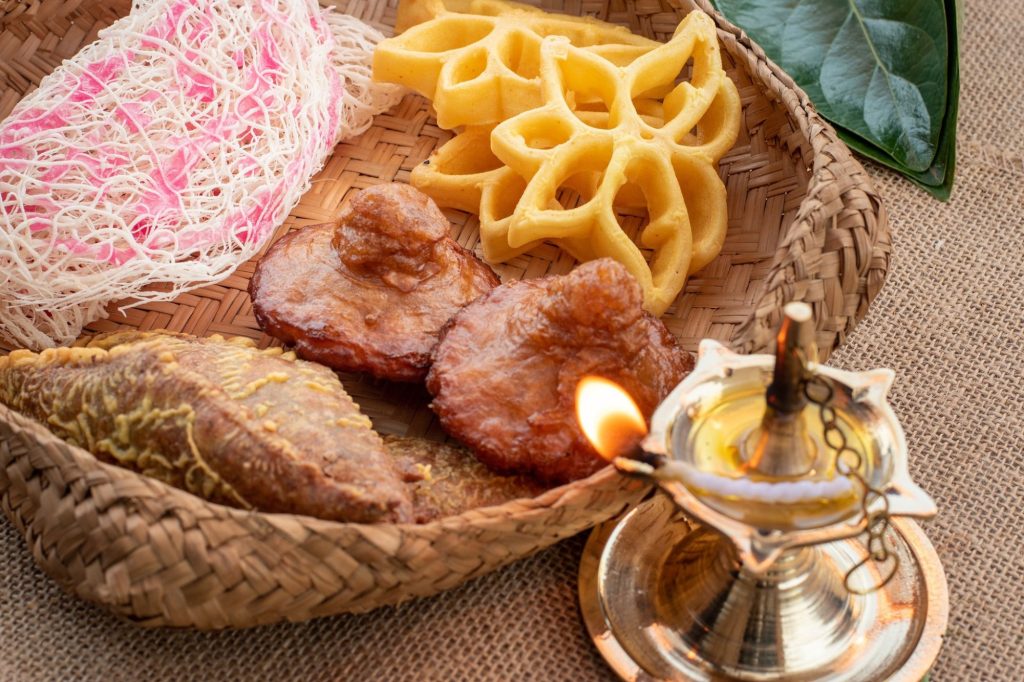
Aluth Avurudda, or the Sinhala Tamil New Year, is an important cultural celebration for Sri Lankan’s and Tamils worldwide. The harvest season ends, and the Sinhala and Tamil new year begins. The festival starts in mid-April and lasts several days, with various ceremonies and customs. The new year involves making and sharing food and sweets. This article examines traditional and modern New Year’s sweets and meals.
Traditional Sinhala Tamil New Year Food
The Sinhala and Tamil New Year is celebrated with family and friends. Family recipes complete many celebrations. Famous New Year dishes:
Kiribath
Kiribath is fundamental to Sinhala and Tamil New Year celebrations. Curries, sambols, and other toppings are added to fluffy coconut milk-cooked rice. Families build festive kiribath balls or diamonds.
Katta Sambol
Katta Sambol goes with Kiribath. Shredded coconut, chili powder, salt, lime juice, and a squeeze are needed. Sri Lankans like Katta Sambol’s heat.
Acharu
Pickled carrots, cucumbers, and beets make acharu. Acharu enhances taste.
Ambul Thiyal
The new year features Ambul Thiyal, a sour, spicy fish dish. A rich, aromatic tamarind and spice sauce braises delicious fish.
Watalappan
Sri Lankans adore the watalappan dessert. Velvety. Coconut milk, jaggery, eggs, cardamom, and nutmeg make this treat. Heating makes custard.
Sinhala Tamil New Year Sweets
New Year’s celebrations include desserts. Sugarcane juice or palm sap (jaggery) is used in these baked goods. New Year’s celebrations demand sweets.
Kokis
Kokis is a jaggery-coconut-rice flour dough. The dough is cooked in intricate Kokis molds. Sinhala-Tamil New Year kokis.
Athirasa
Rice flour, jaggery, and coconut milk make athirasa, or kavum, a delightful rice cake. Golden, crispy, deep-fried dough rounds Athirasa commonly contain hot tea or coffee.
Pani Walalu
Pani Walalu is a sweet ball made with roasted rice flour, jaggery syrup, cardamom, and cinnamon. rolling cool balls. New Year celebrations include tasty and healthful pani walalu.
Kondakavum.
Rice flour, jaggery, and coconut milk make Konda Kavum, a deep-fried doughnut. Deep-fried dough rings are golden and crunchy. Sri Lankans adore crispy Konda Kavum.
Halape
Steaming halape requires kneading rice flour and jaggery. banana leaves into steamed dough balls. Cardamom- or nutmeg-flavored halape is delicate and sticky.
Modern Takes on Sinhala Tamil New Year Food and Sweets
Some households celebrate the New Year with non-Sinhala Tamil cuisine and spices. Contemporary Sinhala/Tamil New Year dishes:
Curry.
Restaurants and home cooks have revolutionized New Year’s meals. A chef may make a curry using Thai and Indian components. Fusion curries let you try new tastes without sacrificing comfort food.
Non-Sugar
Honey or maple syrup replace jaggery in New Year’s sweets. These jaggery substitutes taste different and may be healthier.
Vegan alternatives
Many households cook vegan New Year’s feasts as the vegan community grows. Kiribath may use almond or coconut milk. Plant-based comfort food is available to everyone.
Sweets
Chefs and home cooks made innovative New Year’s dishes. Contemporary kokis use alternative flours or additives. They’re tasty.
eCommerce
Get Sinhala and Tamil New Year meals online for delivery. Online New Year meals from restaurants and home cooks make traditional food more accessible.
Conclusion
Ultimately, the New Year is celebrated enthusiastically in Tamil and Sinhalese-populated areas. Family and friends cook and eat traditional dishes and sweets during the holidays. Sinhala and Tamil New Year sweets and savory dishes range from kokis and athirasa to fusion curries and vegan options. The holiday celebrates family, friends, and Tamil and Sinhalese culture.
Leave a Reply